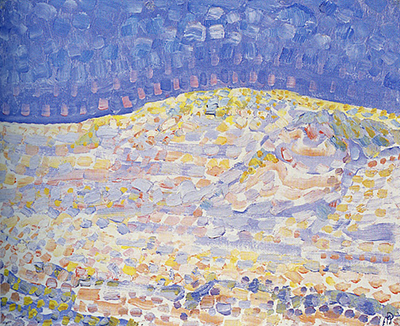Mondrian's time in Domberg, Zeeland was entirely fruitful, gifting us a number of study pieces where the artist was experimenting with both colour and technique. This piece is one of several depictions of dune formations that he produced whilst holidaying here.
Even from the small images that we have provided, it is stil fairly easy to understand the process in which Mondrian worked here. The pointilist shapes of colour, produced by small dabs with the brush, will have come right at the end, after initial work had been carried out in filling the main areas with gradients of colour. He would use the same colours right across the work, whilst the tones showing through from the background would help the eye to construct the main elements of the composition within our minds - namely the rolling dunes, the beach below and also the bright sky above. These colours are upliftingly positive and in line with the direction of modern art at that time. The drabness of previous generations was gone, and famous names like Mondrian were starting to work with a much truer feeling of freedom and enthusiasm for the future.
Most of Mondrian's work in Domberg can now be found in the collection of the Gemeentemuseum in the Hague, Netherlands, with the rest spread thinly between a number of private collections. A similar piece to this was recently sold for $700,000, which underlines the value of these paintings, even though they are not the artist's most famous or technically impressive. The Hague institution itself also holds the sister painting of Pointillist Dune Study, Crest at Centre, which was naturally produced in the same year of 1909. They have near identical dimensions and were both produced as oil on canvas, with limited palettes and a pointilist approach to the sky and beach parts of their respective compositions.




